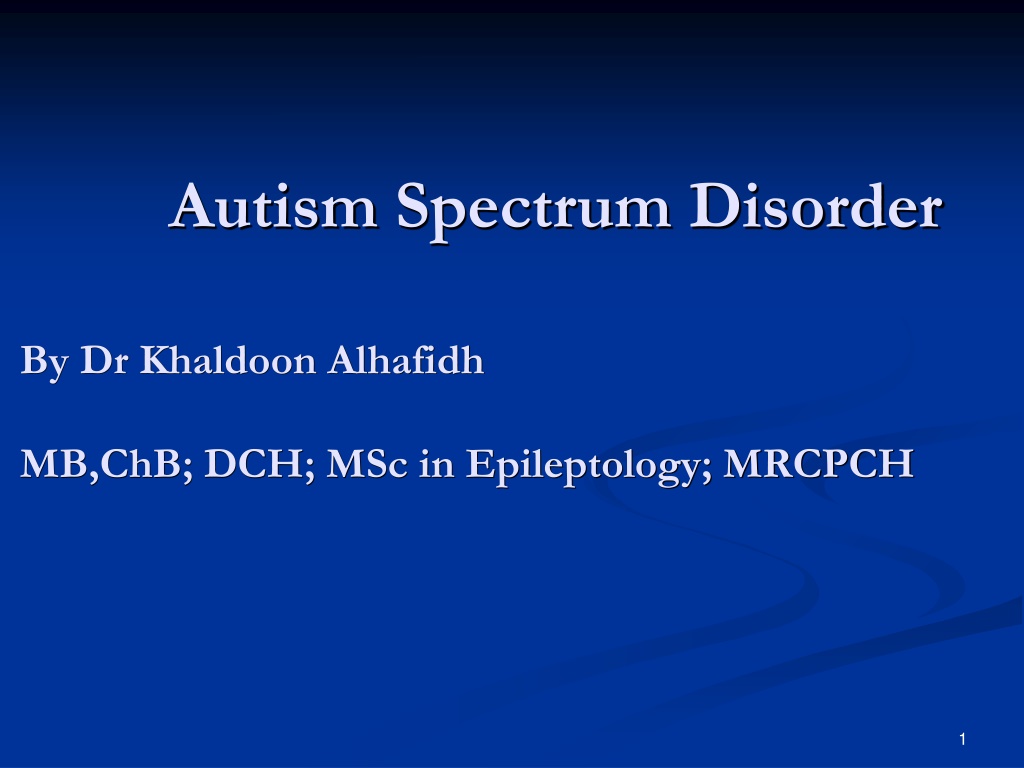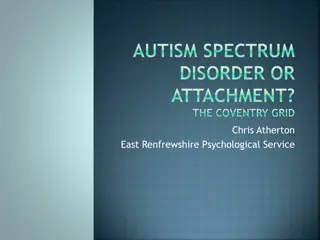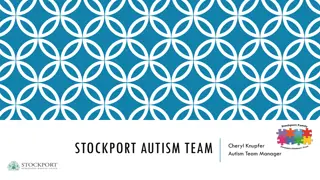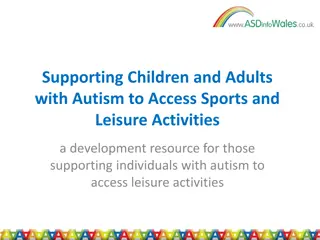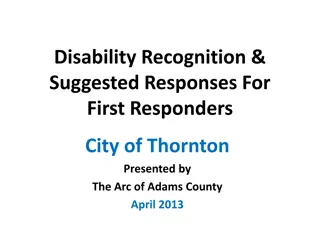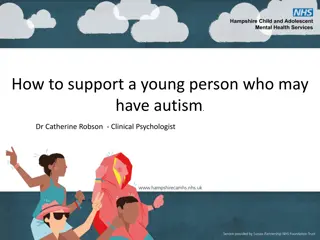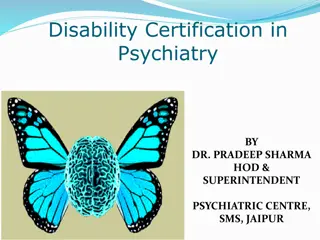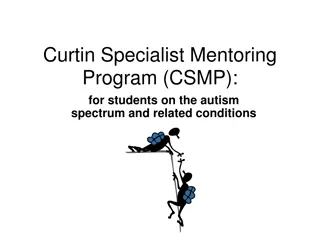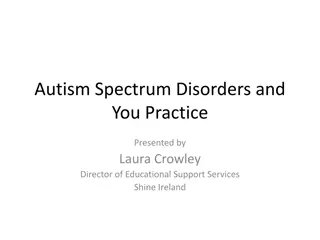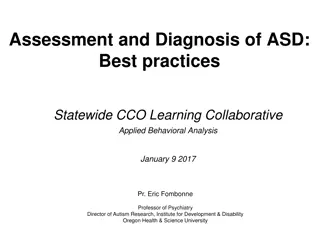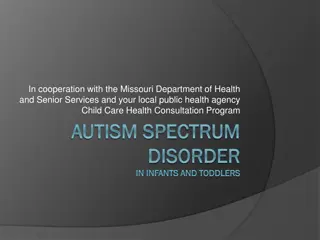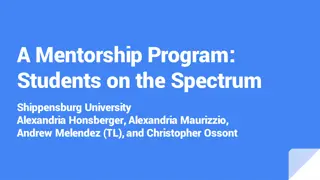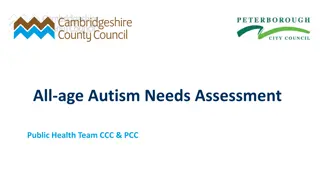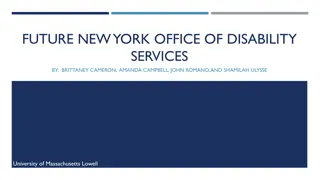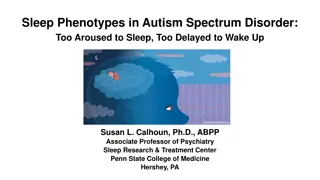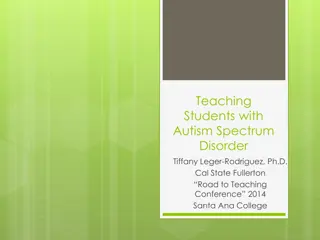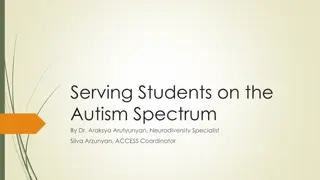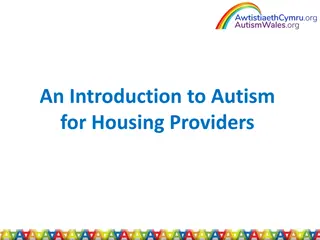Understanding Autism Spectrum Disorder: Overview, Characteristics, and Treatment
Autism Spectrum Disorder, a complex neurodevelopmental condition, presents challenges in social interaction, communication, and behavior. Individuals with autism may exhibit impaired social interactions, speech and language disorders, repetitive behaviors, and co-morbid conditions like learning difficulties and seizures. While there is no cure, early diagnosis and intervention with effective approaches such as therapy and support can greatly improve outcomes. Asperger Syndrome, a milder form on the spectrum, is characterized by less severe social impairments and restricted interests. Understanding the causes and symptoms of autism is crucial for proper management and support.
Download Presentation

Please find below an Image/Link to download the presentation.
The content on the website is provided AS IS for your information and personal use only. It may not be sold, licensed, or shared on other websites without obtaining consent from the author. Download presentation by click this link. If you encounter any issues during the download, it is possible that the publisher has removed the file from their server.
E N D
Presentation Transcript
Autism Spectrum Disorder By Dr Khaldoon Alhafidh MB,ChB; DCH; MSc in Epileptology; MRCPCH 1
OVERVIEW What is Autism Spectrum Disorder? Is there more than one type of Autism? What causes Autism? What are the characteristics of Autism? How is Autism diagnosed? What are the most effective approaches to treating Autism? Is there a cure? 2
AutismSpectrum Disorders 4
Impaired Social interactions: Gaze avoidance Socially and emotionally inappropriate, no appreciation of other feelings Inability to play and interacting with peers. No imaginative play 5
Speech and Language disorder Delay or lack of spoken language, Echolalia Difficulty in starting or continuing a conversation Inflexible or repetitive use of language limited use of gestures and facial expression Monotonous voice,Echolalia, refers to self as 'you' 6
Repetitive, Inflexible Ritualistic Behaviors Obsessive with parts of objects Violent Temper Tantrum when disturbed Self Stimulating Behavior (SSB) e.g, hand flapping and tiptoe gait 7
Co-morbid items: General learning and attention difficulties( about two-thirds) , Seizures( about one-quarter, often not until adolescence) 8
Scenario A child with Autism 10
Asperger Syndrome Milder impairment in social interactions, and presence of restricted interests and activities No clinically significant general delay in language They are often clumsy Average to above average intelligence 1dpoj 12
Famous People suspected to haveAsperger's Syndrome 14
Rett's Disorder Complex neurological disorder Genetic in origin Primarily in girls Present at birth but more apparent during second year Second most common cause of severe learning disability in girls 1:10,000 to 1:23, 000 diagnosed Period of regression including loss of communication skills, and purposeful hand movements 15
Conclusion on types Autism is a spectrum disorder This means that symptoms and characteristics can present themselves in wide variety of combinations, from mild to severe Autistic individuals can be very different from each other Autism is still commonly used to refer to any of the 5 PDDs 16
Benefits of Early Diagnosis Treatment and intervention effectiveness Skill acquisition exposure 17
Diagnosis No definite test.Team uses interviews, observation, and specific checklists developed for this purpose. CHAT( CHeck list for Autism in Toddlers) and other tests Team might include Paediatric neurologist, psychologist, developmental pediatrician, speech/language therapist, learning consultant, etc. Must rule out Mental Retardation , TS, hearing impairment, behavior disorders 18
Types of Treatments/Interventions Interpersonal Relationship Intervnetions and Treatments Skill-Based Interventions and Treatment Cognitive Interventions and Treatment Physiological/Biological/Neurological Interventions and Treatment Other Interventions, Treatments and Related Agents 21
Others Mercury: Vaccinations and Autism (limited support) Gluten-Casein Intolerance (limited support) Music therapy (limited support) 22
Prognosis 70% remain severely handicapped 50% develop useful speech 5% will lead independent adult lives 23
